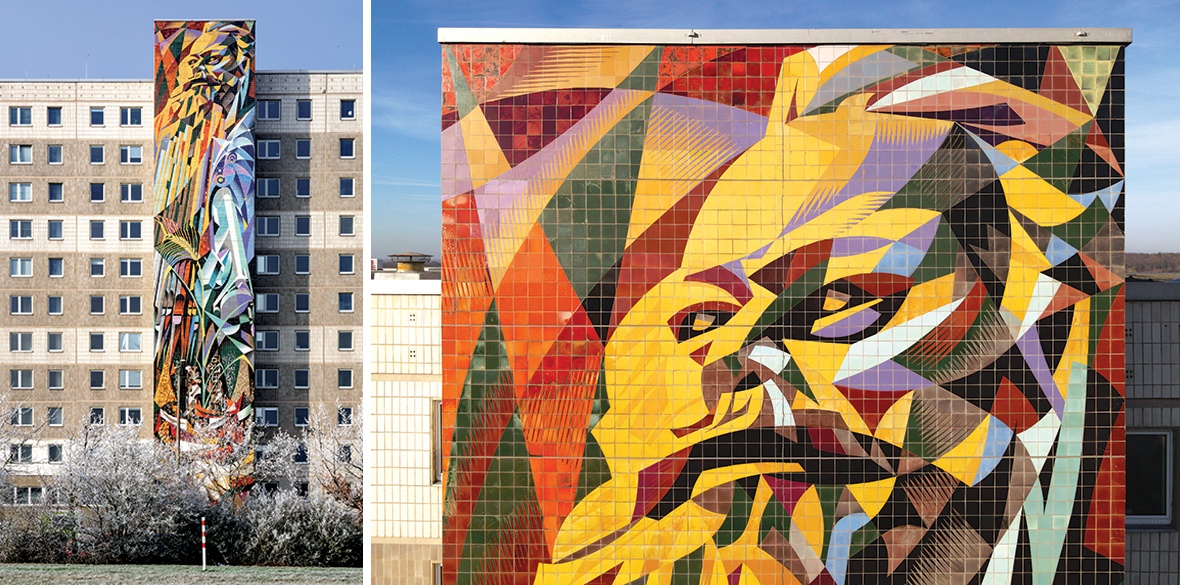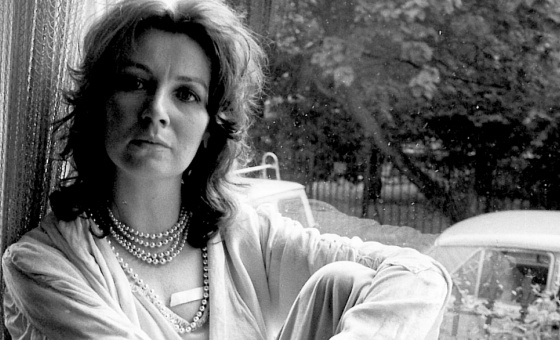This is the last article you can read this month
You can read more article this month
You can read more articles this month
Sorry your limit is up for this month
Reset on:
Please help support the Morning Star by subscribing here
FIFTY years after their creation, a colossal mosaic artwork featuring Karl Marx has been restored in the east German city of Halle.
“One resident told me that she can hardly get her husband away from the living room window, because he is so happy that ‘our art’ has been taken care of,” said Philip Kurz, managing director of the Wuestenrot Foundation, who helped fund the restoration along with the local council.
“People used to be proud that this art existed in the public space and now they can be again.”
Titled The Forces of Nature and Technology Controlled by Man and The Unity of the Working Class and the Founding of the GDR, the mosaics are some of the most important surviving public artworks produced in East Germany.
They were created by Josep Renau, a Valencian artist and communist revolutionary, after settling in the German Democratic Republic, having escaped from Franco’s Spain.
The mosaics decorate the facade of the immigration office in Halle-Neustadt, a socialist model town on the outskirts of the main city, that was built in the late ’60s to house workers at nearby chemical plants.
After the fall of the wall, aggressive capitalist transition took its toll on the town, and privatisation and deindustrialisation resulted in job losses and depopulation. Yet despite the dismantlement of the socialist state, Renau’s bold and ideologically supercharged artwork defiantly remained in place.
Restorers invested a staggering 5,000 hours to bring the works back to their original pristine state, repairing the 11,136-tile work piece-by-piece. Fortunately, when it came to replacing broken pieces, the studio managed to procure the same porcelain stoneware tiles that were used initially.
With their vibrant colours and striking geometric shapes reminiscent of Cubo-futurist art, Renau developed his distinctive style through his graphic design work, creating republican posters during the Spanish civil war.
Following his exile, he spent time in Mexico and rubbed shoulders with communist painter and muralist David Alfaro Siqueiros. Renau went on to complete Siqueiros’s mural for the electricians union after the Mexican artist went on the run due to his involvement in an unsuccessful attempt to assassinate Leon Trotsky.
After this collaboration, he remained dedicated to producing art for public spaces. In a lecture that took place a couple of years before he died in 1980, Renau exclaimed: “I don’t paint for the central committee, I don’t paint for the party, I don’t paint for the art critics, but I paint for the people who are not interested in painting.
“In order for people to see art today, they have to go to a museum, a gallery or an exhibition, but in my opinion that is wrong, because art has to come to the people, without asking.”
The piece in Halle was Renau’s first major project in his new home and his first-ever exterior mural design. It was one of many public artworks commissioned by the council to brighten up the sea of prefabricated buildings that were rapidly built to address the country’s housing shortage.
Today many of the artworks remain — mosaics decorate the local school and swimming baths, a painting of Lenin adorns the side of one housing block, and statues and fountains are scattered throughout the area.
According to the council’s head of culture Jane Unger, public art is a core part of Halle’s local identity, contributing to why restorations like Renau’s are “almost exclusively evaluated positively” by residents.
Halle’s Social Democrat Mayor Egbert Geier hailed the 35-metre mural as “one of the most distinctive works of art in the public space of Neustadt.” He insisted that: “Without question, it is part of our cultural heritage and therefore it’s a great cause for us to maintain and preserve it.”
But the preservation of communist art has become increasingly contentious, particularly further east, following Russia’s war with Ukraine.
Kiev introduced a “de-communisation law” in 2015 following the annexation of Crimea, resulting in the destruction or alteration of public art works containing communist symbols. Russia’s invasion last February renewed the purging of communist monuments, mostly on war memorials, across Europe.
This sentiment has also appeared in Germany, where the Christian Democratic Party made hysterical calls to melt down a statue of communist leader Ernst Thaelmann in Berlin and donate the proceeds to Ukraine. Ironically, Lev Kerbel, the prolific Soviet sculptor who created it, was himself Ukrainian.
Although such concerns have mostly addressed Soviet art, the treatment of heritage from socialist East Germany can also be divisive. From the cult of “Ostalgie” to the proliferation of Stasi lit, the GDR is simultaneously demonised and put on a pedestal.
In terms of public art, even if works aren’t removed outright, the decision to allow works to deteriorate is in itself ideological.
When it comes to the ethics of preserving work from the era, Mr Kurz maintains that “the art created in the GDR belongs to German history. It tells us about our past, about ruptures and perhaps about dead ends.
“We think that if a society only preserves the art that fits into the current political landscape, then it would be pretty poor.”
Indeed, Germany's government does not seem to have its sights set on aligning with the principles advocated by Renau’s mosaics, which promote equality and innovation, supported by a commitment to public welfare.
In April, news surfaced that neoliberal finance minister Christian Lindner, from the business-centric Free Democratic Party, was plotting to slash €20 billion in government spending in 2024, primarily targeting welfare programmes.
In such a climate, one can hope that the mosaics’ positive reception indicates not just a desire to reflect on Germany’s socialist past, but stands as a testament to aspirations for the future as well.












